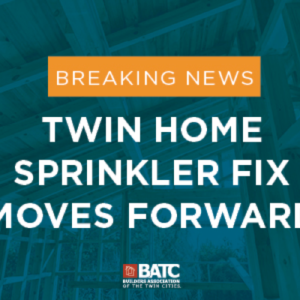On Thursday, BATC’s Regulatory Affairs Subcommittee held its meeting for the second quarter of 2017.
First on the agenda was a look into the BATC v. DLI technical fix banning sprinklers in twin homes that was recently signed into law by Gov. Mark Dayton. Subcommittee member Steve Behnke of Donnay Homes and Nick Erickson, regulatory affairs manager, represented BATC and the housing industry at the DLI meeting on this topic earlier this week. DLI aims to have draft language of the proposed rule available earlier this week, with final adoption of the rule this summer.
In addition to the BATC v. DLI technical fix, the group reviewed other regulatory issues, including:
- 2018 Construction Stormwater Permit: The Minnesota Pollution Control Agency (MPCA) will be releasing the draft 2018 Construction Stormwater Permit this summer. BATC submitted recommended improvements to the MPCA in April and will be engaged with the MPCA as it prepares for the final adoption of the permit later this year.
- Lead Paint/RRP Rule: The EPA is reviewing the current Lead Paint/RRP Rule and is also engaged in negotiations with the Minnesota Department of Health about MDH taking local custody of the rule. Changes at the state and federal levels would affect BATC’s member remodelers and any work done in pre-1978 homes.
In addition to these, the group discussed several local issues BATC is currently engaged with, including:
- Stillwater Permit Delays: In February, BATC members and staff met with the City of Stillwater about the lengthy process for obtaining building permits from the city. Earlier this week, the City of Stillwater announced it has reduced the time to process permits to be more in line with the rest of the metro area. A follow up meeting on this topic is set for later this month.
- City of Dayton Planning Commission: Last week, BATC members and staff met with the City of Dayton’s Planning Commission about design standards being considered by the city. The industry shared its concern that the proposed ordinance would have a negative effect on home affordability in Dayton.















